WWII Lorin Ramjet Experiments
Compiled by Kimble D. McCutcheon
From the Paper "Ramjets for Fighters" by Eugen Sänger and Irene Bredt, originally published Oct 1943
Translated by Intelligence (T-2), Air Documents Division, Translation Section, Headquarters, Air Materiel Command, Wright Field, Translation No. F-TS-901-RE, Release Date Aug 1947
A copy of this translation was kindly provided to the AEHS by Jose Gros-Aymerich
Published by the AEHS 1 Sep 2020
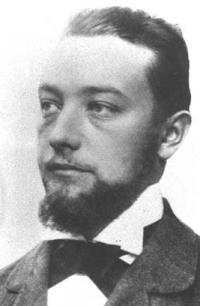
René Lorin (Wiki) |
René Lorin (24 Mar 1877– 16 Jan 1933) was a French aerospace engineer who invented the ramjet and pursued its theoretical development from 1908 through 1913. Although he received French patent No. 390256 and published several articles in the journal L'Aérophile, he was unable to build his invention because no airplane at that time that was fast enough to make it function.
The subsonic ramjet that Lorin conceived, which is also known as an athodyd (aero thermodynamic duct), is an air breathing subsonic jet engine in the form of a continuous duct that uses the engine's forward motion in conjunction with its shape to compress incoming air. Fuel is added to the compressed air, ignited and the resulting hot gas accelerated through a nozzle, producing thrust.
The concept lay essentially dormant until WWII, at which time Eugen Sänger and Irene Bredt realized that by using high combustion temperatures in a subsonic athodyd, practically unlimited performance with fuel consumption values between gas turbines and rockets might be possible.
Approximate performance calculations for a subsonic ramjet installed in a fighter indicated the aircraft could, after a rocket-assisted takeoff, climb to an altitude of 18,000 m (59,040 ft) in 3 minutes and fly at a speed of 950 km/hr (590 mph). Sea level endurance would be nearly 0.5 hr at a speed of 1,100 km/hr (684 mph) |
Theory
 |
Eugen Sänger and Irene Bredt
(Getty Images) |
Eugen Sänger (22 Sep 1905 – 10 Feb 1964) was an Austrian aerospace engineer best known for his contributions to lifting body and ramjet technology. Irene Reinhild Agnes Elisabeth Sänger-Bredt (24 Apr 1911 – 20 Oct 1983) was a German engineer, mathematician and physicist. Bredt married Sänger in 1951.
Starting in mid-1942, Sänger and Bredt became interested in the performance possibilities of the subsonic Lorin athodyd. They began with approximations of thrust, performance, fuel consumption and efficiency in a ramjet with a 10° diffuser taper, a cylindrical combustion chamber, and a conical decompression nozzle.
The initial results were encouraging, so they embarked on more detailed calculations, which validated the approximate calculations. At the conclusion of this second round of calculations, Sänger and Bredt penned the following observations:
- Thrust increased at essentially the square of flight speed and the square root of combustion temperature. At sea level and 300 m/sec, thrust equaled about 3,000 kg per square meter of main bulkhead area.
- Efficiency also increased essentially at the square of flight speed.
- Propulsion power increased at about the cube of flight speed, producing more than 12,000 hp per square meter of main bulkhead area at sea level and 300 m/sec.
- Fuel consumption decreased approximately in proportion to the flight speed reciprocal up to about 1.2 kg/sec at sea level and 300 m/sec.
- With flight speed held constant absolute thrust and propulsion power decreased at higher altitudes.
- Thrust and propulsive power were controllable at a given altitude and speed by changing the exhaust cross section and regulating the fuel supply.
- Larger units that avoided irregular internal gas flow could be expected to have propulsion power on the order of five digits.
- Maximum specific power could be expected to be about 50 hp/kg (23 hp/lb).
- Low weight and elimination of moving parts resulted in low production and maintenance costs, along with long life.
- Since the Lorin athodyd utilized a steady combustion process, it was not sensitive to the type of fuel used; light and heavy hydrocarbons, alcohol, metal dispersions and metal alkyls were mentioned.
- Lorin athodyds were only slightly sensitive to climatic conditions, such a frost, sand, etc., which promoted constant readiness, negligible warm-up and considerable invulnerability to enemy fire.
- The steady continuous combustion developed very little noise.
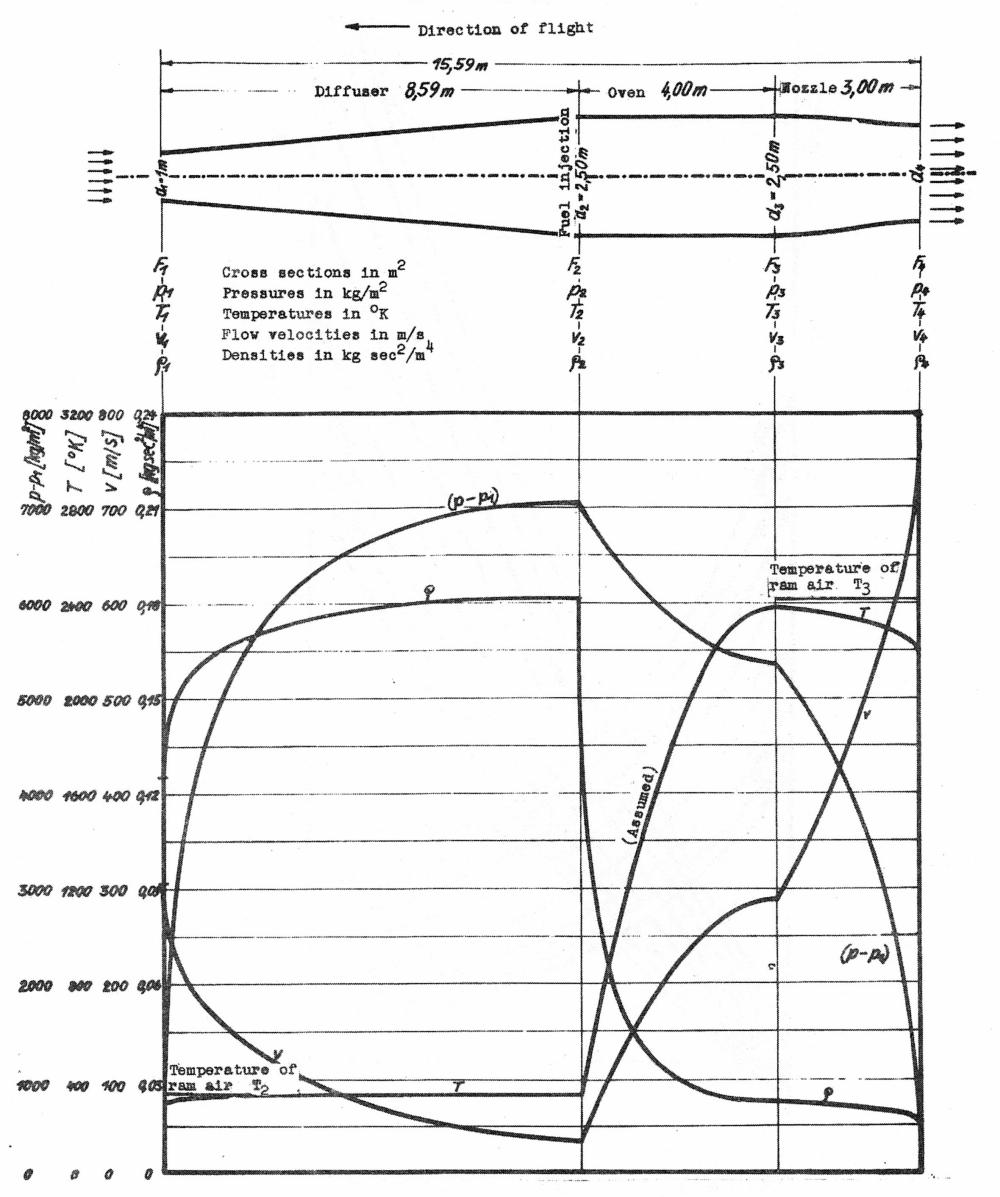 |
Approximate Characteristics of an athodyd with a 2.5 M (98.4") Diameter in Flight near Sea Level at 1,100 km/hr (682 mph).
Thrust = 32,800 lb; Thrust Coeficient (cv) = 0.57; Fuel Consumption = 1.1 kg/sec (2.6 lb/sec); Propulsive Power = 67,000 hp. |
In the above diagram and following graphs, thrust may be represented as a propulsion coefficient, cv, relative to the main bulkhead area F3.
cv = 2((T3 – T2)1/2 – 1) F1/F3, where T2 and T3 were the absolute temperatures at the diffuser and combustor exits. F1 / F3 had been experimentally determined to be 0.16.
Fuel consumption, B, was measured in kilograms per ton of thrust per second.
v/a = Mach number.
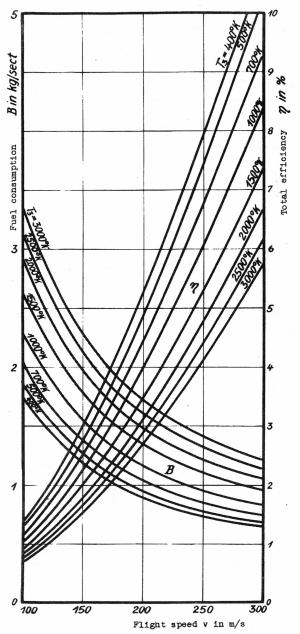 |
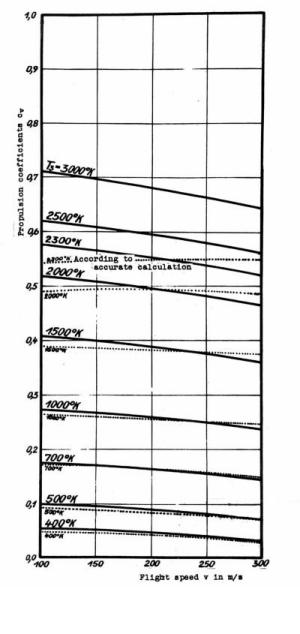 |
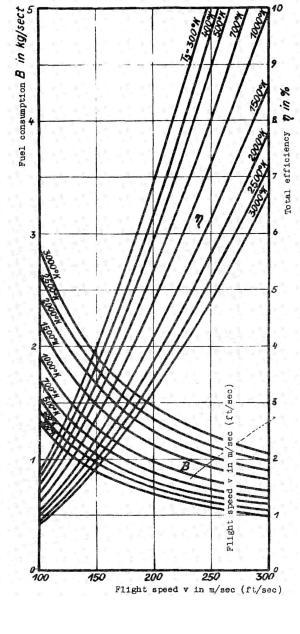 |
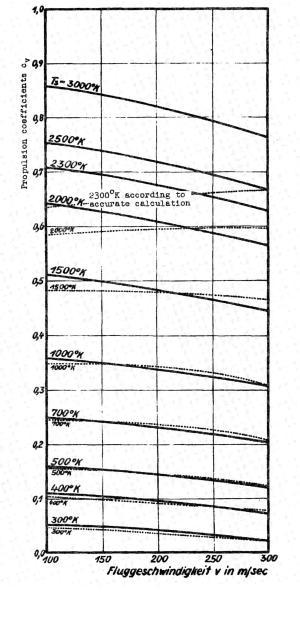 |
| Approximate Athodyd Efficiency and Fuel Consumption at Sea Level with an Outside Air Temperature (T1) = 288°K |
Athodyd Propulsion Coefficients (cv) at Sea Level with an Outside Air Temperature
(T1) = 288°K. Solid lines are approximations; broken lines are more accurate calculations. |
Approximate Athodyd Efficiency and Fuel Consumption in the Stratosphere with an Outside Air Temperature (T1) = 216.5°K |
Athodyd Propulsion Coefficients (cv) in the Stratosphere with an Outside Air Temperature
(T1) = 216.5°K. Solid lines are approximations;
broken lines are more accurate calculations. |
Ground Testing
The theoretical predictions were so favorable that Sänger and Bredt sought to confirm the results experimentally as soon as possible. Since there was a growing threat from Allied bombing attacks, the tests were planned so they could be accomplished rapidly and results applied directly to a flying version. Therefore, time-consuming construction of stationary test stands was never considered. Instead, Testing up to 25 m/sec (56 mph) aboard a road truck, which they called towing tests, was adopted. The lesser accuracy of towing tests was outweighed by the advantage of fresh-air conditions, especially in regard to turbulence, air density, moisture, etc. The towing tests also allowed Sänger and Bredt to validate that the desired temperature conditions could be created, that the dimensional proportions were correct, and that the combustion chamber walls were robust enough to handle the temperature and pressure resulting from liberating 20,000,000 kcal/m3 (2,246,000 BTU/ft3/hr).
Aviation gasoline was injected via spray nozzles near the inlet rim and ignited by continuous injection of small amounts of highly pyrophoric diethyl zinc, which, when exposed to oxygen, ignited spontaneously. After numerous towing tests, during which various fuel injector nozzle configurations and injection pressures were tried, the team succeeded in creating stable combustion that melted a 0.05 mm platinum-iridium wire with a melting point of 2,180°K. This wire was suspended 2.2m behind the fuel injection point. After accounting for the considerable heat radiation of the fuse wire, the team determined combustion temperature was around 2,400°K.
Through careful pressure measurements, the team validated that the 10° diffuser angle was optimal and that the ratios of diffuser, combustor and nozzle dimensions were satisfactory.
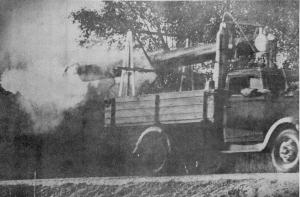 |
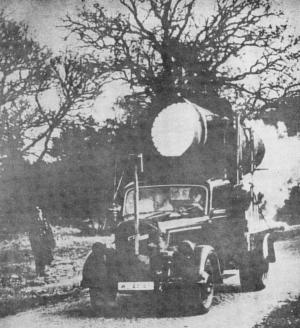 |
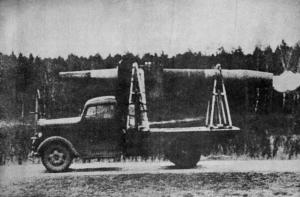 |
| Athodyd Road Towing Test to Investigate Injection and Combustion Ratios |
Athodyd 800 mm (11.49") Combustion Road Towing Test to Investigate Injection and Combustion Ratios at 2,400°K |
High Temperature Athodyd for Measuring Diffuser Efficiency |
Flight Tests of a 2,400 hp Athodyd
A new athodyd was constructed with an intake diameter of 200 mm (7.87"), a 10° diffuser angle, a combustion chamber that was 2,960 mm (117") long and 500 mm (19.7") in diameter. Its rated power was approximately 2,400 hp at 300 m/sec (671 mph). Fuel was injected through several spray nozzles at the diffuser exit perimeter. The number, injection direction, and pressure of the fuel injection were varied, as was the exhaust cross section.
This athodyd was mounted atop a Dornier Do 17Z for a total of 70 flight tests at speeds up to 100 m/sec (224 mph); each test lasted about 300 sec. The mounting scheme allowed measurement of thrust and drag, as well as pressures at various points within the athodyd. These tests again confirmed the calculated performance and highlighted the importance of correct fuel/air ratio in achieving maximum efficiency.
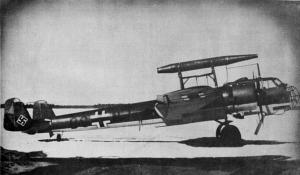 |
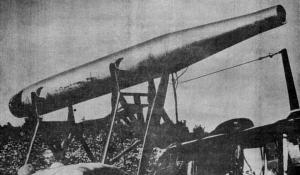 |
 |
| Dornier Do 17Z Test Airplane with 2,400 hp Athodyd |
Dornier Do 17Z Test Airplane with 2,400 hp Athodyd Thrust Test Apparatus |
Dornier Do 17Z Test Airplane with 2,400 hp Athodyd in Operation at 85 m/sec (279 mph) |
Flight Tests of a 20,000 hp Athodyd
Another athodyd was constructed with an intake diameter of 600 mm (23.6"), a 10° diffuser angle, a combustion chamber that was 4,000 mm (157") long and 1,500 mm (59.0") in diameter. Its rated power was approximately 20,000 hp at 300 m/sec (671 mph). Fuel was injected at the diffuser exit through 20 to 120 injectors at pressures ranging from 4 to 11 atm (57 to 156 psi). The fuel system consisted of a 700 l (185 gal) tank, pressurized with nitrogen, with a pressure regulator between the tank and injectors.
The athodyd was mounted atop a Dornier Do 217 E-2, which provided testing speeds between 100 m/sec (223 mph) and 200 m/sec (447 mph). The team measured thrust, fuel consumption and pressures at various points within the athodyd while observing the combustion process.
The Do 217 with the athodyd attached was capable of obtaining a speed of 90 m/sec (201 mph) in horizontal flight; with the athodyd running, speed increased to 120 m/sec (268 mph). A series of increasingly steep glides achieved the higher speeds. The limiting speed was reached when the Do 217's elevator control reached the limit of its authority to counteract the nose-down moment resulting from increasing thrust from the high-mounted athodyd.
Heat sensitive paint applied to the combustion chamber outer surface indicated the chamber wall to be below 600°C (1,112°F) at low speeds, less as speed increased. Slightly incomplete combustion, as indicated by the bright exhaust flame, was expected to be improved by heating the fuel before injection.
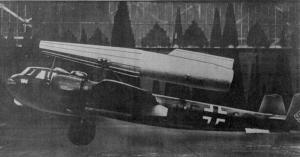 |
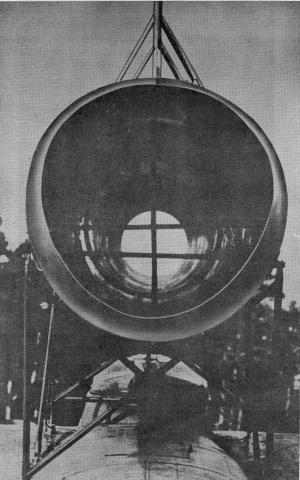 |
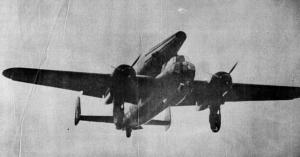 |
| Dornier Do 217 E-2 Test Airplane with 20,000 hp Athodyd |
Rear View of 20,000 hp Athodyd on Dornier Do 217 E-2 Showing Fuel Injection Cross |
Dornier Do 217 E-2 Test Airplane with 20,000 hp Athodyd |
Flight Tests with a Special Airframe
Since athodyd testing using existing airframes was restricted to speeds below 200 m/sec (447 mph) a special airframe was required to achieve 300 m/sec (671 mph). Sänger and Bredt envisioned that such a test aircraft could be towed to an altitude of a few thousand feet, whereupon both the tow plane and test plane would dive, thereby achieving a velocity that would start the athodyd and raise its thrust to a sustaining value. Such a test aircraft, complete with a pressurized cabin, was under construction during October 1943 when the report was written; there is no evidence it was never completed.
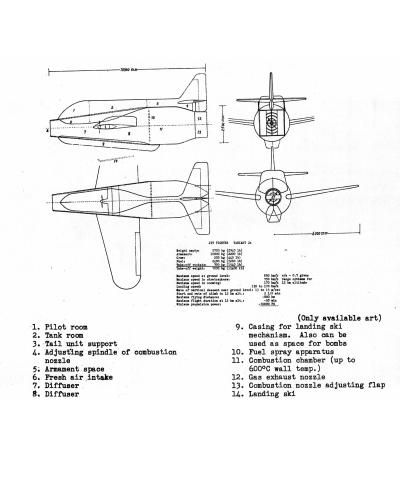 |
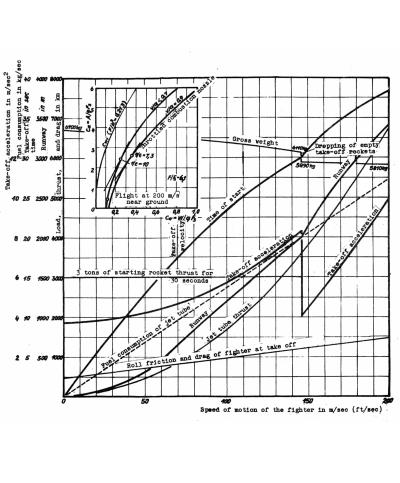 |
 |
| Hypothetical Jet Fighter General Arrangement, 60,000 hp Athodyd |
Estimated Hypothetical Jet Fighter Takeoff Performance |
Estimated Hypothetical Jet Fighter Climb Performance |
Applications Envisioned
Several athodyd-powered applications were suggested, including airplanes, armor-piercing bombs, glide bombs and aerial torpedoes. However, the most promising application was in various airplane power plants. Sänger and Bredt envisaged a 2,500 mm (98") double-walled light-metal monocoque athodyd forming the fuselage of a jet fighter. A cabin for the crew and fuel, a rudder, an elevator were to be attached on the dorsal surface; a wing and landing gear to the ventral surface. They estimated a 3,400 kg (7480 lb) empty weight and 6,000 kg (13,200 lb) gross weight, which included 2,400 kg (5,280 lb) of fuel.
Two rockets, one attached to either side of the aircraft would get it airborne and accelerate it at low altitude to a speed sufficient for the athodyd to become active. The rockets would then be jettisoned. At that point, two scenarios were explored: one at ground level and the other at high altitude.
At ground level, the hypothetical aircraft would fly at a speed of about 720 km/hr (447 mph) for a maximum of about 1,690 sec, giving it a range of about 338 km (210 mi). Higher speed was possible with a corresponding range and endurance reduction. At slower speeds the aircraft could be used as a bomber with considerably greater range.
High altitude operation would begin with takeoff and climb to an altitude that would give it air superiority at a speed of about Mach 0.9, theoretically as high as 20,000 m (65,600 ft). Its range and endurance would depend on operating altitude and speed. For example, at 12,000 m (39,360 ft) and at Mach 0.9, the aircraft would have sufficient fuel to fly for 3,280 sec, giving it a range of 870 km (539 mi). Better endurance and range were achievable at lower speeds. The combination of rapid climb to altitude and ability to loiter made it ideal for anti-bomber roles at altitudes ranging from 8,000 to 18,000 m (26, 246 to 59,054 ft).
Conclusion
Around 1944, every available drop of aviation gasoline was reserved for Germany's defense efforts. Sänger and Bredt attempted to substitute pulverized coal, but this was not successful. The combination of fuel scarcity and waning Luftwaffe support brought an end to the athodyd experiments. Sänger and Bredt remained active in the European aerospace community after WWII.


















